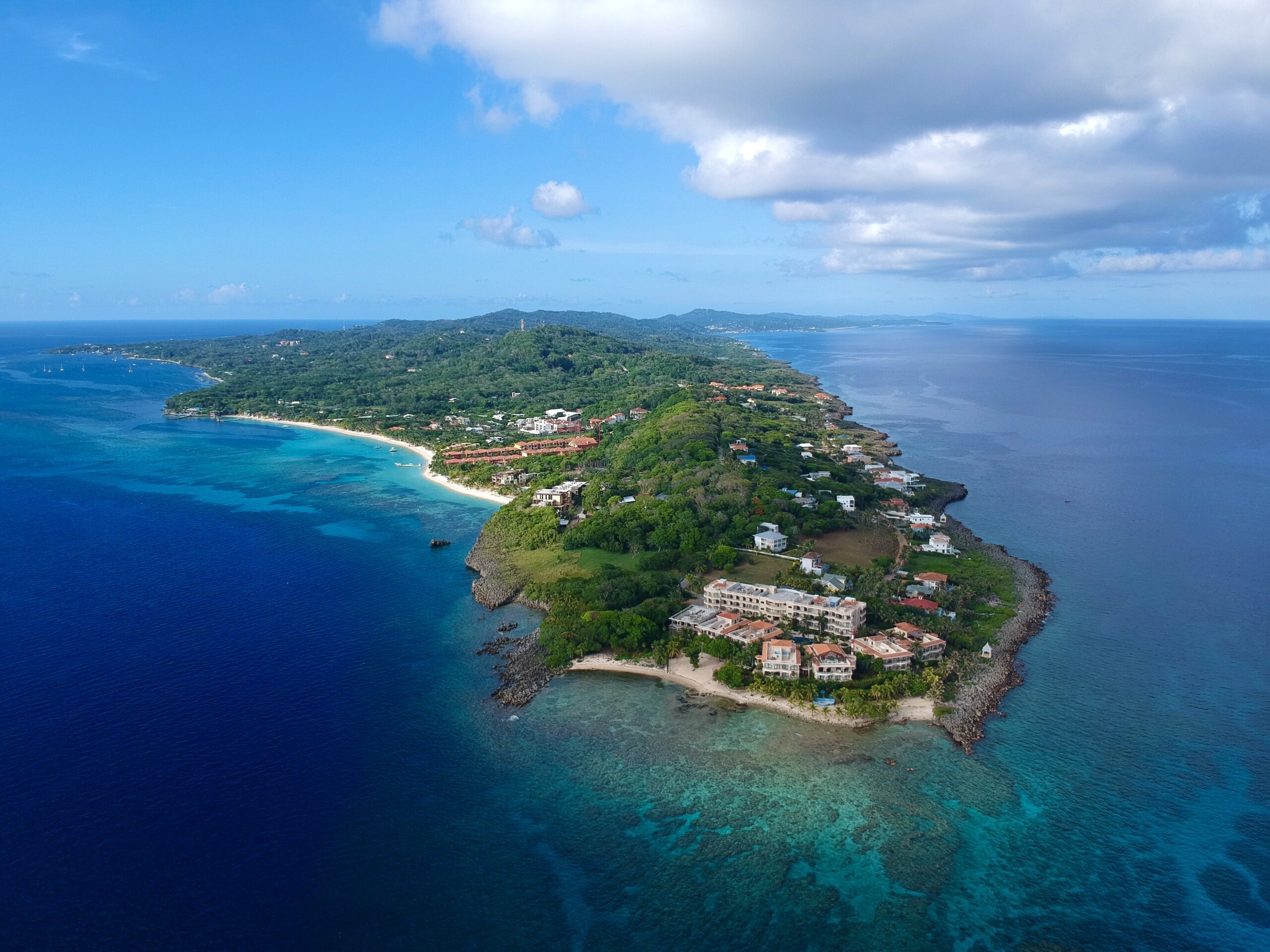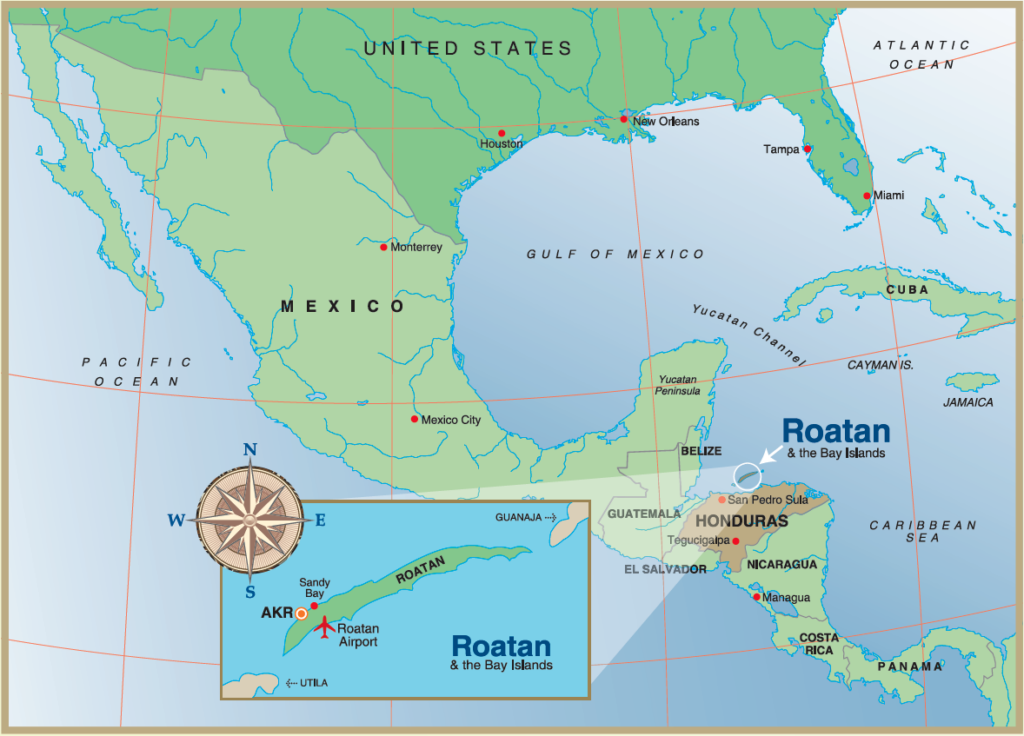
About Roatan Island
Roatan’s Geographical Significance
Roatan is located in the Western Caribbean (16°S, 86°W), approximately 35 miles (56 km) north of mainland Honduras. Roatan is the largest and most developed of the Bay Islands, with an area of 49 sq. Miles (12,740 hectares). It has a 30-mile-long E-W axis and a 1-2-mile-wide N-S axis. The other main islands are Guanaja (29 sq. miles) and Utila (16 sq. miles). These islands form a 75-mile (120 km) crescent along with three smaller islands of Helene, Morat, and Barbareta, and 65 smaller keys, of which you’ll find 23 of them off the shores of Roatan.

Roatan’s Topography: A Mountainous Terrain
Roatan has a mountainous backbone; only 2% is considered level (less < 5% grade). Its steep peaks, some rising as high as 1,300 feet, make the island poorly suited for agriculture. While most of the island has slopes between 30 and 75%, it can reach 90% in some areas. Most level areas are swampy.
Climate and Weather Patterns in Roatan
Temperatures on Roatan hover between 77 and 88 °F. The rainy period occurs between October and January. Rainfall exceeds 6 ft (2,000 mm) annually, most of which falls during the rainy season. While the length of the dry season can vary, the average is three months. Precipitation totals less than 100 mm from February through June, with the period of dry soil from March through May. The warm, crystal-clear waters surrounding Roatán range from 78˚ to 84 °F.
Wind and Humidity: Roatan’s Atmospheric Conditions
The Bay Islands lie in the trade wind belt, and east-to-southeast trade winds with 19 to 26 mph velocities are relatively constant. Periods of up to 5 days of dead calm are common in August, and each winter, 5 to 7 North American cold fronts (“northers”) reach the islands, bringing wind shifts to the north and west, overcast skies, and prolonged rainfall. On the islands’ northern coast, winds typically blow from the east. The almost continuous influence of trade winds results in a characteristic condition of high relative humidity. While Roatán lies farther west than the paths of most Atlantic hurricanes, one large one is estimated to occur every 10 years. Before Hurricane Mitch in 1998, Hurricane Fifi in 1974 was the worst in recent times: wind speeds reached over 100 miles per hour, and over 20 inches of rain fell.
Flora: Roatan’s Rich Botanical Diversity
The island’s vegetation has been modified over the years as agriculture and the introduction of exotic species (cashews, mangos, almonds) have occurred. Despite the alteration, the warm, moist climate still supports a lush diversity of plant life. Over 50% of the island is under some forest cover. Several vegetative types prevail. Primary, secondary, mixed, and pine forests are found on the higher ridges. Located on the lower valley slopes are small rainforests, like growths of tall hardwoods, dense palms, lianas, orchids, and ferns. A thorn-scrub association is somewhat widespread in Roatan. There are also several areas of concentrated mangrove cover and beach vegetation around the island. The native pines and oaks that inspired Columbus to name the Bay Islands after them still exist, though they no longer cover such a large area. Other native species include the gumbo-limbo, cecropia, strangler fig, and many different palms. The trunks and branches of each tree are home to a variety of orchids, lianas, ferns, and bromeliads. Drier sites are home to acacia and mimosa, both with sharp thorns.
Roatan’s Wildlife: A Haven for Endemic Species
The terrestrial ecosystems on Roatan support abundant wildlife. While many species found here are the same as those on the mainland, the Bay Islands’ isolation has allowed some endemic species to evolve. There are presently nine species and two subspecies of animals endemic to the Bay Islands. Some of these species are the Roatán Parrot (Amazona xantholora), the Roatán Agouti (Dasyprocta ruatanica), the Roatán Coral Snake (Micrurus ruatanica), the Marmosa (Marmosa ruatanica) (mouse opossum), and the Rosy Boa (Boa constrictor). Five species are mollusks, as described by Professor Emilio Garcia of Louisiana State University in cooperation with RIMS. Wildlife that is extinct or extirpated from the Bay Islands includes the Caribbean Monk Seal (now extinct), the West Indian Manatee, and the Brown and Red-Footed Boobies.
Embracing Roatan’s Natural Beauty
We reflect on the remarkable tapestry of Roatan’s attributes. Nestled in the Western Caribbean, this island is a symphony of nature, with rugged mountains, lush forests, and diverse wildlife, including several endemic species. Its climate, shaped by trade winds and seasonal variations, adds to the island’s allure, creating a haven for adventure and relaxation. The unique blend of geographical features and rich biodiversity underscores Roatan’s status as a Caribbean jewel. As we consider its delicate ecosystems and the rare beauty they harbor, there’s a compelling call for mindful exploration and conservation. Roatan isn’t just a destination; it’s a vibrant, living ecosystem that invites us to immerse ourselves in its natural splendor while advocating for its preservation.
